Organizational Objectives That the HR Function Is Responsible for Delivering
In a dynamic and productive work environment, those functions HR specialists are responsible for playing an essential role in implementing organizational objectives. Employees in this department interact with human resources and perform numerous tasks that allow establishing a highly efficient workflow that helps stimulate productivity and look for optimization opportunities.
In Figure 1, the implication diagram of the HR functions is presented, and a large number of valuable links attests to the importance of performing relevant activities to achieve organizational goals and objectives (Objectives, scopes, and functions, 2018). The competent realization of these functions, in turn, makes it possible to improve the outcomes of work by stimulating employees’ commitment and professionalism.
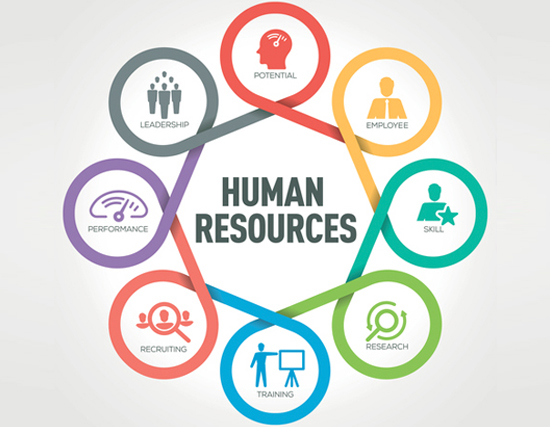
In a modern business environment, many organizations strive to strengthen the HR function to realize meaningful development objectives and increase productivity by prioritizing specific tasks. Panda, Das, and Tripathy (2020) cite the example of IKEA, the globally recognized brand, and note that the corporation uses individual practices intentionally to follow the chosen course. The authors argue that price leadership is a priority for this company, and all interventions associated with HR activities aim to create an appropriate business background (Panda, Das, and Tripathy, 2020).
In general, the strategy of prioritizing roles in a team is a convenient technique that allows correlating business objectives with real interventions and attracting all available resources for monitoring and managing personnel. In Figure 2, a diagram is displayed, which shows unique correlations among trends in the labor market and the strategic relevance of measures taken by HR professionals (Panda, Das, and Tripathy, 2020). This graph demonstrates the volumes of needs and their significance in specific working conditions and may vary depending on the goals and objectives of individual organizations.
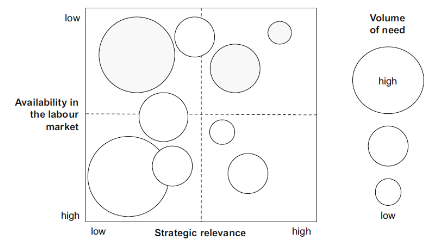
When paying attention to the aforementioned organizational objectives, in particular, staff training, productive recruiting, stimulating the acquisition of skills, and other tasks, one can note multitasking entrusted to HR specialists. At the same time, addressing one of these functions is impossible without addressing others because, in case of gaps in one area of work, productive interventions in others are unlikely.
Panda, Das, and Tripathy (2020) argue that the strategic importance of human resources management goes beyond employee training since those interventions that are promoted at the organizational level have broader implications. If a company promotes a unique recruitment strategy, this means that, in addition to the selection system, numerous areas of work are involved, in particular, skill control, training, capacity assessment, and other aspects. In other words, multitasking that is inherent in modern HR departments is natural and necessary in a dynamic work environment and market competition.
Therefore, business organizations strive to correlate development objectives with the HR function and create a stable and effective mechanism for controlling the internal processes of interaction with personnel. Thus, the prospects for business development largely depend on the quality of this mechanism.
As an HR manager, one needs to meet critical organizational objectives associated with the enhancement of employees’ organizational performance. Among the key organizational objectives that an HR manager needs to meet, one might mention the goals such as increasing employee satisfaction, maintaining workplace ethics and providing employees with decent training opportunities (Panda et al., 2020). The described functions are linked directly to the levels of performance shown by employees.
Employee Satisfaction and the HR Function
Indeed, the rates of employee satisfaction affect the quality of the products and services for which the employees in question are responsible, which is why the extent of employee satisfaction needs to be accounted for in the organizational context (Panda et al., 2020).
The traditional approach toward employee satisfaction implies creating an environment in which staff members are likely to feel comfortable (Panda et al., 2020). However, the approach toward the idea of employee satisfaction has changed over time, shifting from the basic notion of removing impediments to effective work toward the concept of creating the setting where staff members from diverse backgrounds would not be culturally alienated (Objectives, scopes, and functions, 2018). In addition, the notion of talent management as an important constituent of employee satisfaction has been developed. However, certain concepts, such as the power of incentives for maintaining employee satisfaction have remained intact.
Workplace Ethics and the HR Function
Likewise, the lack of compliance with ethical standards disrupts relationships between staff members, encouraging them to engage in conflicts as opposed to producing the required results (Panda et al., 2020)., Consequently, the focus on workplace ethics as one of the cornerstone aspects of proper production levels is needed. The phenomenon of workplace ethics has also undergone significant changes over the course of the HRM theory development.
Specifically, the shift toward the need for diversity in the workplace has affected the ethical framework by changing it toward an inclusivity-driven framework (Panda et al., 2020). In addition, the tendency toward honesty and integrity seems to have been a major focus of managing ethical issues in the workplace recently (Panda et al., 2020).
Training Opportunities and the HR Function
Finally, training options serve as a powerful incentive and produce an immediate effect since they contribute to the rise in career opportunities for staff members (Panda et al., 2020). Thus, it is crucial to consider the described three functions of the HR manager in conjunction with the implementation of organizational objectives, namely, the delivery of the products and services of the expected quality and the ultimate increase in the company’s profit margins.
The specified aspect of the HRM function has also experienced vast alterations across time since the massive role played by employee training and the opportunity for gaining extra competencies has been explored comparatively recently (Panda et al., 2020). Moreover, with the emergence of IT and ICT tools, extra options for sharing experience and knowledge, as well as interdisciplinary cooperation, have emerged, thus boosting the development of training opportunities as an important part of the HR function.
Major Theories of Effective Change Management, Their Implementation, and Evaluation
To have an idea of how the HR function is implemented and what organizational objectives it corresponds to, one should pay attention to the unique theories of change management used to optimize the workflow. Cameron and Green (2019) remark that these concepts utilized by many companies have one significant goal – to transform the work environment in accordance with current needs and enhance productivity in individual industries.
HR specialists involved in this activity act as direct developers of change programs and, at the same time, play supervising roles. Today, there are about ten of the most common change management theories that have unique workflow transformation features and distinctive roles for participants. However, several models are most widely recognized due to the convenience of their implementation and evaluation, and further, the relevant concepts will be considered and analyzed.
Lewin’s Change Management Concept
Lewin’s model is one of the simplest and, at the same time, effective change management concepts. It includes only three stages; at each of them, corresponding actions are performed to ensure a stable process of transition to new working conditions. In Figure 3, this algorithm is displayed (Top ten change management models, 2020). One should take into account that each of the steps follows one another, and this order cannot be changed.
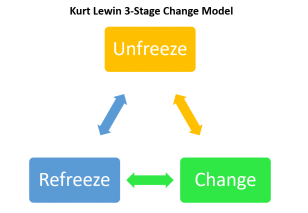
The first stage of refreezing involves introducing measures designed to change the working environment. At this phase, the necessary measures are implemented to switch to the necessary mode of operation and management, and all available resources are engaged. The success of this step is determined by the implementation time and the understanding of the importance of the transition by all involved individuals. The next stage is the process of changes that occur due to the previous step.
At this phase, all the necessary innovations and change programs are implemented while taking into account the fact that all interested parties are ready for the transition to updated working conditions. The success of this step is determined by the time of implementation and the quality of all procedures planned at the initial stage. Finally, the stage of refreezing implies preserving the outcomes of the intervention in the work process and ensuring the sustainability of a new regime. At this step, the results are summarized, and the sustainability of changes is a key indicator of the success of the entire program.
McKinsey’s 7-S Concept
At the heart of this model, there are shared organizational values that form the basic principles of a particular company and what its core business approaches are. According to Cameron and Green (2019), as an accompanying element that forms the principle of any change, McKinsey’s concept also includes a transformation strategy, a change structure, and systems for interventions. In Figure 4, the appearance of such a model is presented, and the key correlations among all its components are displayed based on their interdependencies (Top ten change management models, 2020).
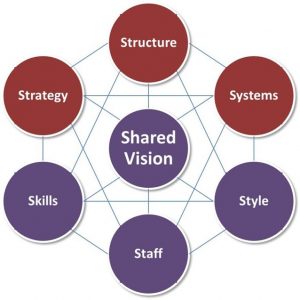
The implementation of this strategy involves referencing all the components presented to implement the desired change programs in accordance with the specifics of a particular organization but not the general principles of business activities. In this case, responsible persons are engaged in introducing the required changes and taking into account the internal characteristics of a company. As an evaluation criterion, maintaining a balance among the components of the model is assessed, and the productivity of the activity proves the success of an implemented change program.
Kotter’s Change Concept
The principle of Kotter’s change model involves a structured system of transition to new working conditions through the phased implementation and evaluation of intermediate interventions. As Cameron and Green (2019) argue, these steps are often referred to as accelerators that contribute to generating changes and involving all stakeholders. In Figure 5, a transition diagram is shown, and all the steps are presented as stairs (Top ten change management models, 2020).

This model is one of the most detailed in terms of implementing individual steps for introducing changes. For instance, unlike Lewin’s concept, Kotter’s theory is based on the preparation and evaluation of each of the eight stages, and all steps have specific objectives and anticipated outcomes. At the first phase, the issue is put forward, and the significance of the changes to overcome it is offered as a justification. At the last stage, the main assessments are carried out, and responsible persons determine how positive new behaviors are in the conditions of an updated model of activities.
Kübler-Ross’ Change Model
In HR activities, attention is paid to not only the professional but also the emotional preparation of employees for specific working conditions. Emotional and psychological unpreparedness for certain changes can be the reason for the lack of the effective development of a company and, consequently, a failure to achieve crucial organizational objectives.
To avoid this prospect, HR specialists can pay attention to Kübler-Ross’ change concept that is a system of adaptation to new operating conditions. Cameron and Green (2019) analyze this model and note that one of its main goals is to help employees overcome their depressive mood caused by an unusual working regime. Visually, this concept is a curve that changes as the workforce adapts to changes, and it is displayed in Figure 6 (Top ten change management models, 2020).
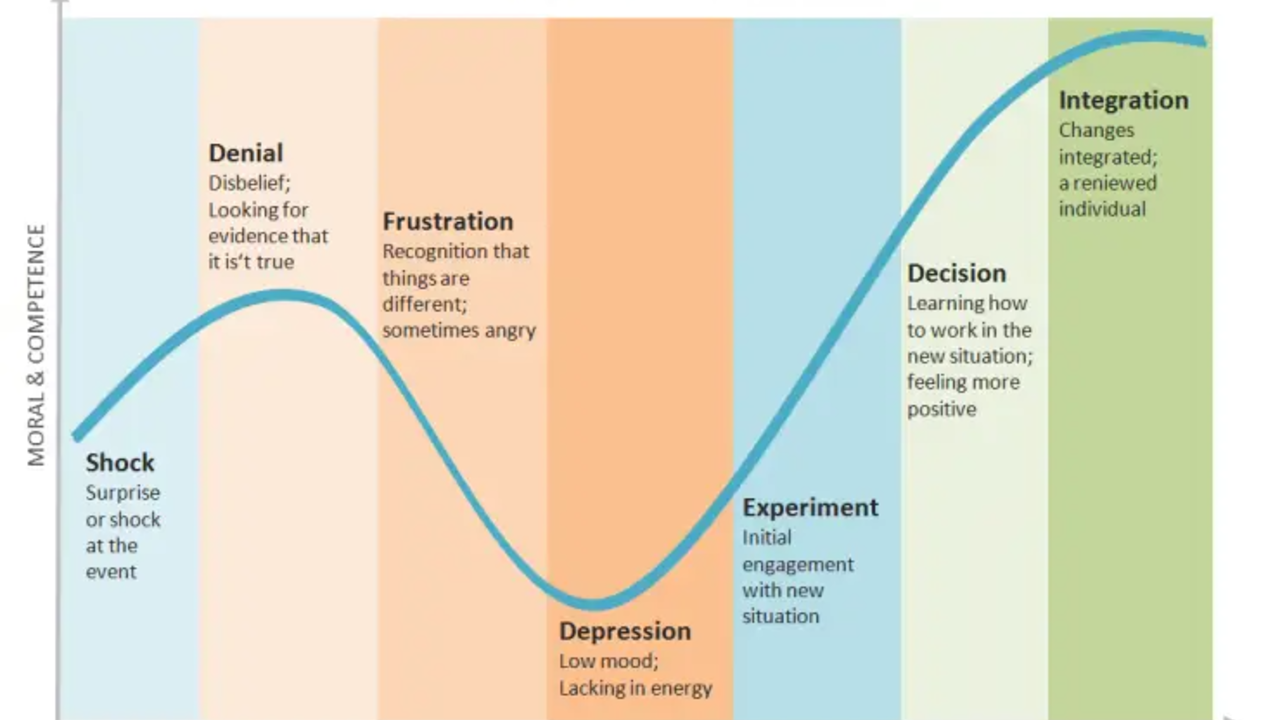
As one can see, the curve includes seven conditions, and among them, depression and integration are the least and the most desirable outcomes, respectively. In the process of introducing changes, responsible persons are to control not only operational nuances but also the perception of specific transformations by employees. The introduction of Kübler-Ross’ model is carried out through the preliminary assessment of the emotional readiness of team members.
At the same time, one cannot argue that any process of change will involve all the seven stages of psychological perception. Nevertheless, if operational shifts are significant, the likelihood of frustration and depression increases significantly. The evaluation of the effectiveness of this model involves analyzing the adoption of changes and the interpretation of an updated model. In case employees perceive the work in an updated mode positively and adequately, the considered model of change management has been introduced successfully.
There are some other concepts of change management that HR specialists can also use to control the productivity of operating mode transformations. However, the proposed theories are the most common ones, and their involvement can make it possible to achieve a successful and quick implementation of the necessary changes in work activities. In addition, combining specific models is acceptable, for instance, the inclusion of both Lewin’s and Kübler-Ross’ concepts to assess employees’ professional and emotional perception of changes. Therefore, the value of these theories is high, which allows them to be used in different working conditions.
Managing HR Professionally, Ethically, and Justly
HR management principles may differ in various companies, which, in turn, affects the productivity of these departments significantly. Too demanding and tough approaches to control HR specialists’ activities can worsen operating results and become barriers to the achievement of essential organizational objectives. To prevent these outcomes, managing HR should be conducted in an ethically favorable environment in which professionalism is encouraged, and just assessments of employee performance are made.
As an example of a business case in which these positive characteristics are promoted, Lelebina and Gand (2018) suggest paying attention to the Alpha company and its management approaches to maintaining sustainable HR practice. Relevant interventions and control principles are significant drivers for strengthening the organization’s industry and enhancing its employees’ commitment.
Alpha is a large organization that sells general consumer goods. As Lelebina and Gand (2018) note, one of the initiatives taken by the company’s leadership to strengthen the HR field was the introduction of a ladder system that provided fair growth opportunities for each employee. The use of this mechanism helped increase the confidence of employees in leaders and create ethically favorable conditions for improving professional qualifications.
At the same time, Delisle (2017) confirms that taking into account the competencies of employees in HR management is an important aspect of quality leadership. Workers feel the individual approach of the management and understand the scope of their obligations, which, in turn, allows them to realize all the assigned tasks as professionally as possible.
The practice of anticipating HR needs, which Delisle (2017) notes in the context of one of the valuable approaches to managing this area, is also advanced in Alpha. According to Lelebina and Gand (2018), a personal-oriented approach allows managers to better understand the needs of subordinates and satisfy them whenever possible. For instance, the authors mention training courses that leaders offer to HR employees and argue that the provision of professional growth opportunities has a positive effect on loyalty and retention indicators (Lelebina and Gand, 2018).
In addition, the value of those evaluations is emphasized that are carried out from outside the company and serve as significant components to analyze the productivity and fairness of work. In Figure 7, the benefits of HR outsourcing are displayed, and this type of practice is one of the tools in obtaining objective and ethically sound assessment results (HR outsourcing, 2018). As a result, Alpha is a successful example of an organization that does everything possible to provide an enabling environment for HR management.
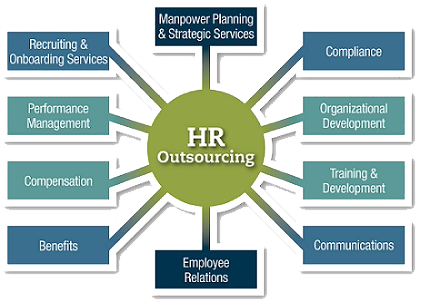
Different Ways of Delivering HR Objectives in Organizations
Various stakeholders are involved in ensuring that the HR function is implemented successfully in organizations. At the same time, managing this industry requires delivering appropriate objectives competently to establish a productive operating environment. According to Reilly and Williams (2016, p. 140), “HR’s role is simply to deliver management’s wishes”. However, to maintain a continuous workflow, delivery should be conducted professionally. One of these methods is informing about particular goals through shared values.
Wallo and Kock (2018) argue that this mechanism involves establishing an effective interaction between HR specialists and company leaders through a system of trust and cumulative benefits. In other words, managers should promote a control principle that can enable them to deliver organizational objectives based not only on leadership but also on HR interests. Achieving development goals should be accompanied by the strategic assessments of current needs and opportunities, and in Figure 8, a possible information exchange algorithm is reflected (Pesonen, 2017). The shared values method helps enhance trust between managers and HR specialists and strengthens cooperation. Therefore, its use in a modern business environment is potentially productive and in demand.
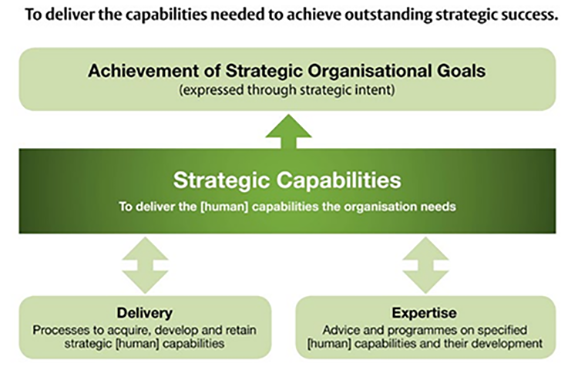
Another method of delivering HR objectives can follow the previous one. This is outsourcing, an approach that involves assessing and implementing the necessary tasks by third parties. As Reilly and Williams (2016) note, today, this practice is widely used in the business environment and, in particular, in the HR industry since it has several advantages. They are an opportunity to improve employee performance, the profitable use of available resources, and other valuable perspectives (Reilly and Williams, 2016).
Nevertheless, in the context of the benefits for delivering organizational objectives, outsourcing can create the conditions under which the interaction of HR specialists with hired personnel will be as unbiased and ethically justified. In the conditions of constant communication with direct supervisors, HR department employees may feel the routine of assigned duties and perform direct work inefficiently. The implementation of an outsourcing program, in turn, stimulates a new look at operational activities and helps arouse employees’ interest. Thus, this approach is one of the mechanisms of delivering organizational objectives and may be applied in companies of different sizes.
Alternatively, an HR manager can turn to the use of the proposed tool HR Business Partner (HRBP) framework as the strategy for delivering the essential objectives related to the HR function. Namely, since the concept of HRBP implies close engagement with workplace teams, it can be incorporated into the process to ensure that key goals are achieved. An HRBP will allow making the supervision process and the management of quality more accurate, thus preventing any defect or instance of mismanaging key organizational goals from taking place.
The application of the HRBP in the organizational context has multiple advantages, most of which center around the ability to manage a significant amount of tasks. Namely, the application of the HRBP technique allows structuring the process of HRM in settings that involve a large number of employees. Another advantage of the HRBP strategy is that it opens an entire pool of opportunities for organizational growth (Reilly and Williams, 2016).
Namely, the incorporation of the HRBP will help to build a vaster perspective and see how changes to the HRM framework affect the company’s performance in the grand scheme. As a result, problems in the management of processes related to production, SCM, and other aspects of a company’s performance can be addressed.
However, applying the HRBP technique will also mean dealing with several disadvantages. For example, the framework in question suggests that the key HRM responsibilities are distributed among a range number of HR executives, which leads to higher expenses and less efficient management of human resources in the workplace. Indeed, once a company starts assigning a specific responsibility to each staff member, the process of HRM will become very convoluted and rather difficult to implement, thus obstructing the company’s performance.
In addition, the integration of the HRBP approach may prevent an organization from meeting its actual needs since core production processes have the tendency not to align when integrating the HRBP technique into the corporate setting. Therefore, one may need to reconsider the application of the HRBP framework to the context of a small company with a limited number of resources and rather straightforward goals.
Varieties of the HR Function in Different Organizations and Sectors
Since the functions that HR employees perform are flexible and have a purpose of addressing different organizational objectives and tasks, their application in various sectors can be distinctive. The company under analysis, which functions in the food sector and is currently positioned as an SME yet plans to expand in the nearest future, has been implementing the Functional Strategy, for the most part, neglecting the Administrative and Strategic aspects of the HRM process to a large extent. In Figure 9, a graph is presented, which reflects the types of HR roles in organizations (Rédelé, 2017). As variables used as determinants, the size of the companies is applied (X-axis) and the impact of HR activities on a particular business (Y-axis).
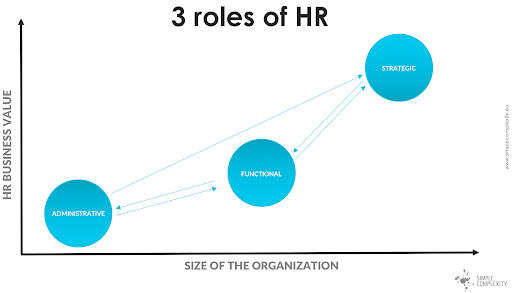
Based on this graph, one can note that the transition from an administrative role to a strategic one is directly proportional to the size of an organization. However, despite the focus on expansion and the related changes to its perspective and HR function implementation, the firm has been avoiding the transition to the next stage of its HRM development. Overall, the current approach adopted at the target organization aligns best with the principles listed in the Harvard Model of HRM.
The similarities between the model and the company under analysis are quite striking; namely, the firm in question tends to consider the needs of its stakeholders as the primary issue that defines the strategies that it needs to implement in order to attain the needed results.
Moreover, similarly to the premise of the Harvard Model, the approach used at the target organization tends to view the changes made to the HR approach as having long-term consequences on the levels of engagement and, therefore, the quality of performance in staff members (Reilly and Williams, 2016). The proposed administrative perspective on the management of HR objectives has been working quite well for the firm, yet, with the expansion, it will need to introduce a more elaborate function into its practice.
In addition, the strategic function has the greatest impact on any business due to an opportunity to apply unique approaches and tactical solutions to maintain a sustainable work process. For medium-sized companies, the functional role of HR is typical, and this parameter is an intermediate link in the transition from an administrative principle to a strategic one in case of the gradual growth of a company. For example, comparing the company under analysis to another expanding organization, such as Ford Motors, one will notice that the latter has changed its HR framework toward the perspective based on the strategic HRM process (Pratap, 2020).
As a result, the Ford Motors organization has received an impetus for further development since its staff members are capable of aligning their actions and behaviors with the alterations that have occurred to the firm (Pratap, 2020). However, in the other company mentioned above, the specified change has been neglected, which has affected the efficacy of the transition. Fast growth, as can be seen on the graph, allows excluding this middle link. Therefore, as a valuable implication, one can argue that the strategic function of HR, which has a significant impact on the business process, is the most advanced approach that is characteristic of large organizations.
In relation to different sectors, the HR function is also a dynamic variable that may change due to business peculiarities. Kuipers and Giurge (2017) analyze the manifestations of HR roles in enterprises of various profiles and note that, for instance, companies following cost-based strategies tend to implement strategic HR roles more often. This is due to the fact that such firms strive to achieve a competitive advantage, which is impossible if the simplest administrative tactics are followed. Innovation-based strategies, in turn, require a functional approach that promotes the creation of unique market offers and the search for opportunities to strengthen the manufacturing base (Kuipers and Giurge, 2017).
In addition, Kuipers and Giurge (2017) note that the trend of engaging competent HR specialists is typical for private businesses today, although several years ago, in the public sphere, this phenomenon was more common. This means that regardless of specific business purposes, the implementation of the HR function is of value to organizations of different profiles. At the same time, companies’ size is one of the criteria determining specific approaches to personnel management, and this is crucial to consider.
Criteria and Methods Used to Evaluate the Contribution of the HR Function
The HR function is essential for achieving valuable organizational objectives and enhancing performance for a number of reasons. When considering the contribution of this sphere to the success of any enterprise, one can assess its impact in the context of value-added. In case the final results of business activities are higher than those anticipated due to the use of productive HR approaches, this means that the significance of the relevant personnel management measures is high. In Figure 10, the basic factors of successful business outcomes are displayed, and, as can be seen, the activities of HR specialists play a big role in this process (Welcome to the HR revolution, 2020). However, there are more accurate methods and criteria for evaluating the contribution of the HR function.
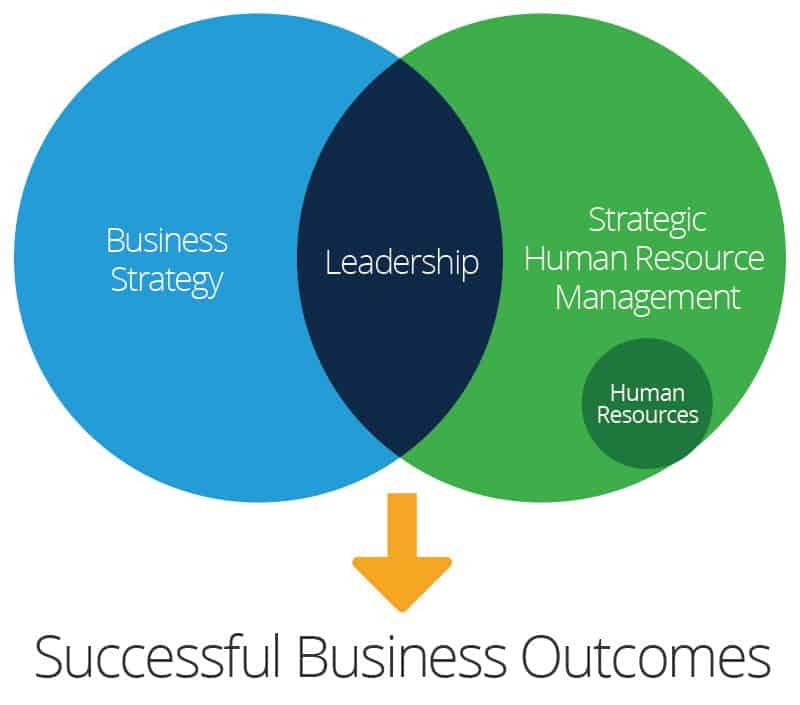
The principles of evaluating the role of HR specialists in a company are determined differently. Phillips, Phillips, and Smith (2016) analyze specific measurement tools utilized for this activity and assess the costs of these practices, and the results of their evaluation are presented in Table 1. When comparing these outcomes, one can note that performance indices and profit indicators are the key factors determining HR success.
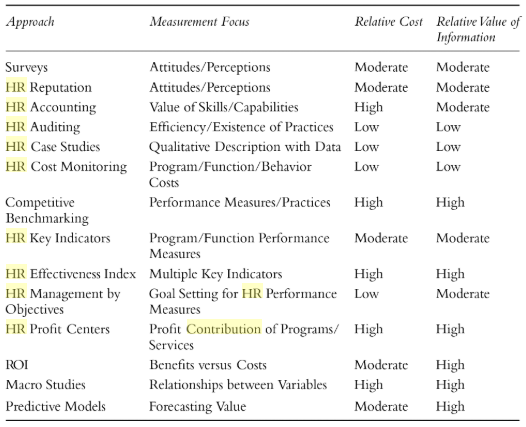
At the same time, predicting the performance of employees of this profile is possible by using standard methods that they use in the work process. One of them is utilizing metrics used to evaluate the activities of the HR department. In Figure 11, a list of possible metrics is presented (van Vulpen, 2019a). As the most significant of them for assessing the contribution to the overall work process, one can single out employee performance indicators, for instance, engagement rating, turnover data, and some other parameters. These tools are convenient for analyzing the quality of HR specialists’ activities and assessing their contribution to companies’ business outcomes.
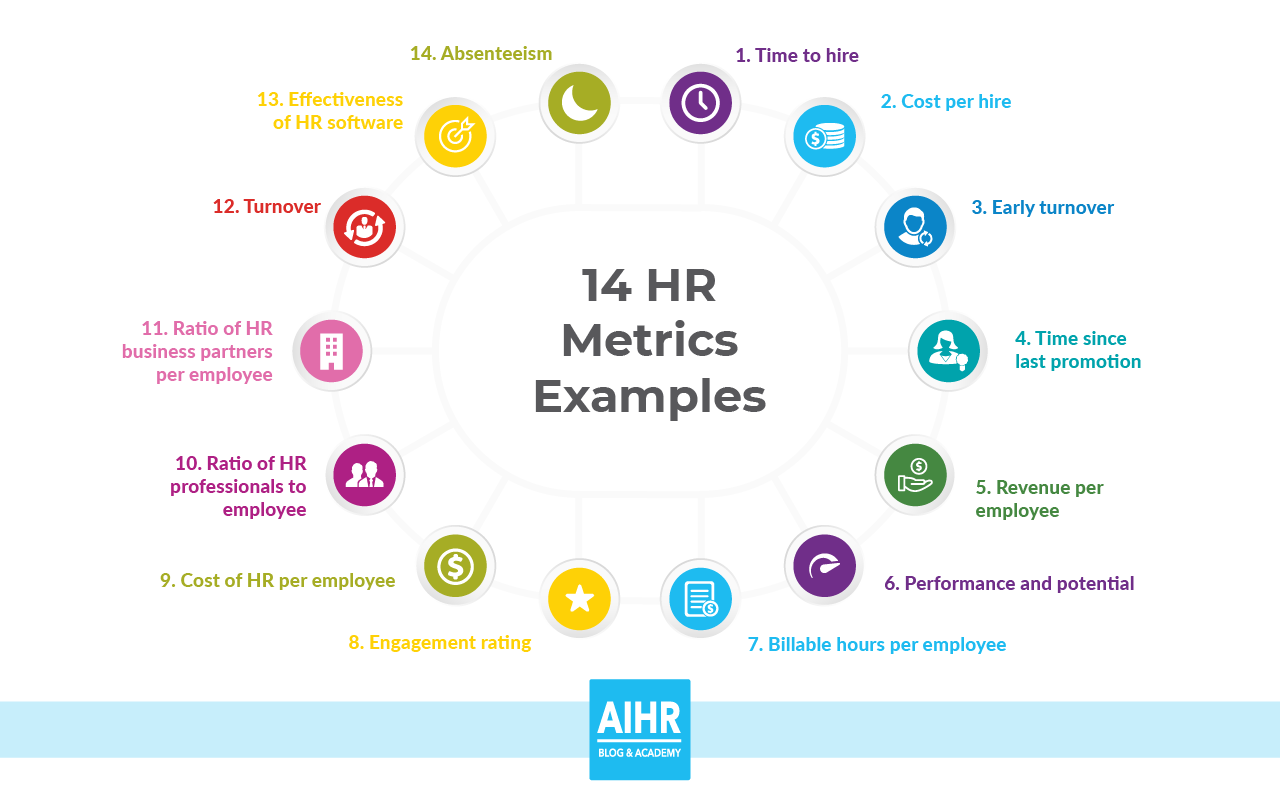
When assessing the contribution of the HR function to business outcomes, there are some barriers. According to Phillips, Phillips, and Smith (2016, p. 54), they are “analytics and evaluation cost”, “lack of top management commitment”, and some other obstacles.
To overcome them, leaders should establish a mode of work, which implies involving all interested parties. If managers are interested in determining which benefits competent HR activities provide, it needs to create an enabling environment for evaluation. Both direct interactions with HR specialists can be supported, for instance, through meetings and conversations, and additional methods, including metrics. These practices are convenient for gaining insight into the relevance of the HR function to a particular organization.
HR Practices Leading to Positive Organizational Outcomes: Research Evidence
Due to a research analysis on the topic under consideration, the assessment of the positive impacts of relevant HR practices on organizational outcomes can be conducted. In particular, findings from academic sources may be used as a justification base. In their study, Latorre et al. (2016) determine the views of Spanish employees concerning the effects of HR commitment on real organizational results and staff performance.
According to these data, from the selected sample, 72.5% of employees confirm the value of training offered by HR specialists (Latorre et al., 2016, p.332). The authors argue that 67.1% of respondents appreciate an opportunity to participate in the decision-making process, which is provided to them as a working condition (Latorre et al., 2016, p.332). The involvement of HRs in maintaining consistently high business development indicators may be explained by the value chain described by van Vulpen (2019b) and shown in Figure 12. These significant aspects of HR practice helps maintain a high-performance work environment and ensure the achievement of essential organizational objectives.
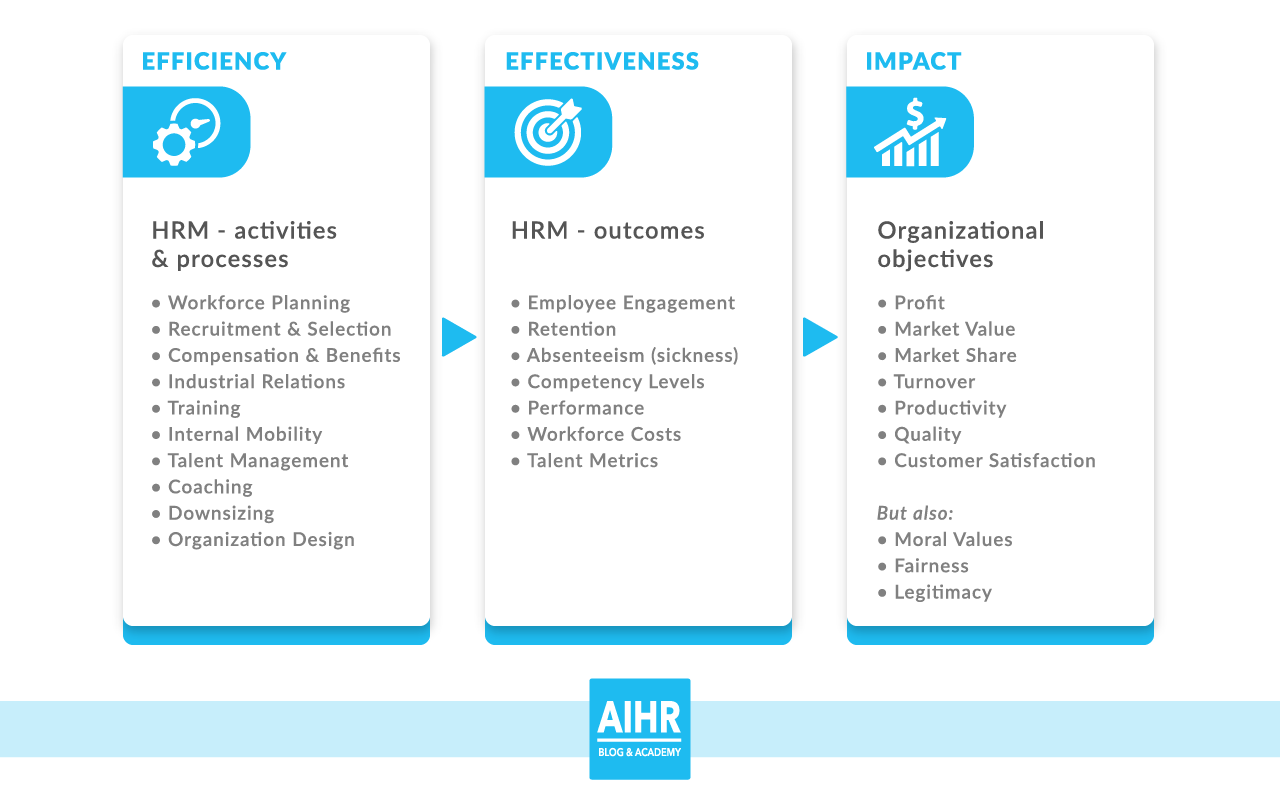
One of the main manifestations of HR’s positive impacts on organizational outcomes is the stimulation of employees’ productive activities. Mostafa (2017) assesses the role of the HR function in the context of performance improvement and notes a direct correlation between effective HR interventions and employees’ job satisfaction. The author examines the data obtained from Welsh government officials and argues that sufficient resources needed for operational changes are a significant aspect of enhancing the HR function (Mostafa, 2017).
Job attitudes and workplace behavior are those indicators that form an idea of the sustainability of the workflow. Due to the productive work of HR specialists and following the values presented by van Vulpen (2019b), companies can count on employee loyalty and ethical and fair interaction among colleagues. Thus, findings from academic sources confirm the importance of competent HR practices in terms of enhancing organizational outcomes.
Impacts of High-Performance Working and Investment in Human Capital on Organizational Practice
Productive organizational practice depends on a number of interventions and tools used to enhance business outcomes and strengthen specific areas of activity. As a special mechanism utilized for this work, Zhou, Fan, and Son (2019, p. 253) analyze high-performance work systems (HPWSs) that “provide job decision latitude and group problem-solving opportunities”.
The authors argue that these systems are interconnected HR practices that can help implement a number of operational tasks and achieve high-performance business outcomes (Zhou, Fan, and Son, 2019). The contribution of HPWSs to organizational practice is significant because the introduction of appropriate HR approaches, such as training, appraisal, and some others, is positively correlated with productivity. In Figure 13, the components of HPWSs are shown, which Thanai (2018) considers, and these systems are the most common auxiliary mechanisms.
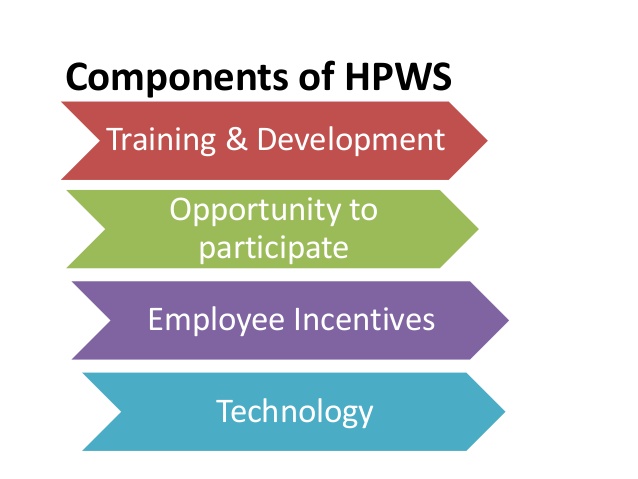
For many business enterprises, gaining a competitive advantage is a major development objective. In this regard, the use of relevant tools and mechanisms to achieve this goal is a significant task. One of the ways implies investing in human capital, thereby increasing potential productivity and expanding the scope of business influence. Fareed et al. (2016, p. 656) mention the resource-based view theory and state that, in accordance with it, “competent human capital is a potential source of sustainable competitive advantage”. In addition, the authors note that there is a direct correlation between investing in this field and employee productivity (Fareed et al., 2016).
HR activities in this direction involve addressing subordinates’ various needs, which, in turn, stimulates the interest of workers and contributes to increasing their professional competencies. In Figure 14, the corresponding implications of such an investment approach are presented (Lyngaas, 2016).
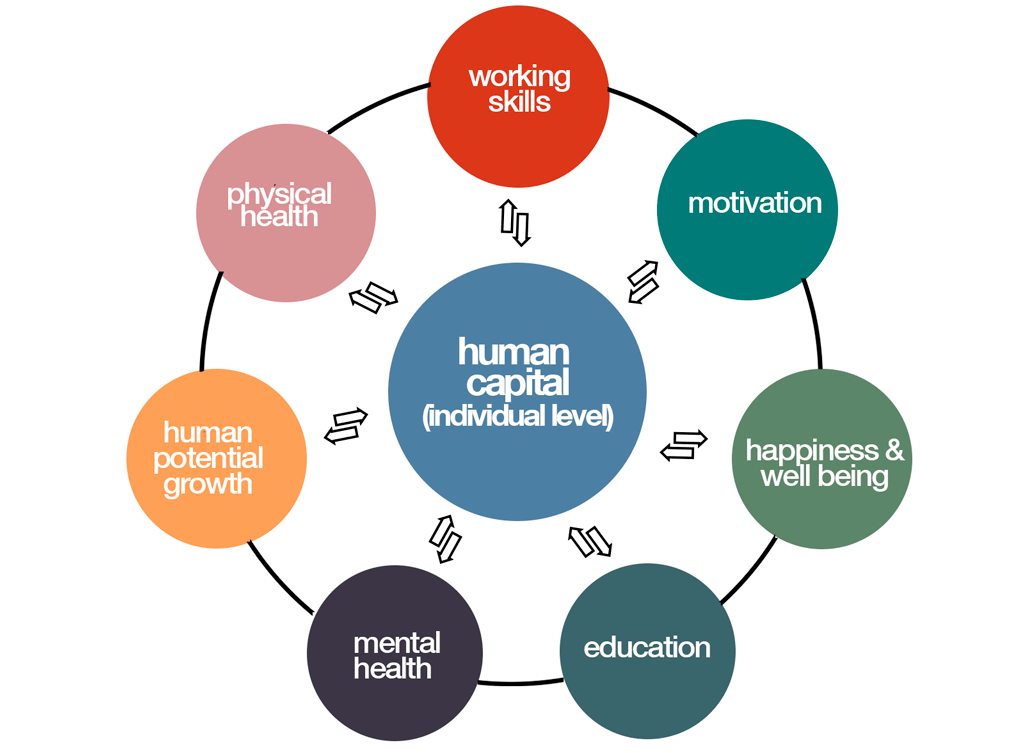
The application of the considered methods of optimizing business outcomes and achieving essential organizational objectives is a crucial practice for many companies. According to Zhou, Fan, and Son (2019), employee participation, as an indicator that largely determines labor productivity, is enhanced by investing in human capital. In case such work is promoted along with the introduction of effective HPWSs, HR activities are successful and contribute to eliminating barriers to improving productivity. Therefore, to gain a competitive advantage and maximum employee commitment, business organizations should pay attention to the practice of investing in human capital and promoting HPWSs in the workflow.
References
Cameron, E. and Green, M. (2019). Making sense of change management: A complete guide to the models, tools and techniques of organizational change. 5th edn. New York: Kogan Page.
Delisle, J. (2017). 7 best practices to manage your human resources. Web.
Fareed, M. et al. (2016). ‘Developing human capital for sustainable competitive advantage: the roles of organizational culture and high performance work system’, International Journal of Economic Perspectives, 10(4), pp. 655-673.
HR outsourcing. (2016). Web.
Kuipers, B. S. and Giurge, L. M. (2017). ‘Does alignment matter? The performance implications of HR roles connected to organizational strategy’. The International Journal of Human Resource Management, 28(22), pp. 3179-3201.
Latorre, F. et al. (2016). ‘High commitment HR practices, the employment relationship and job performance: a test of a mediation model’. European Management Journal, 34(4), pp. 328-337.
Lelebina, O. and Gand, S. (2018). ‘Beyond “hero-based” management: revisiting HRM practices for managing collective expertise’. Relations Industrielles/Industrial Relations, 73(1), pp. 39-66.
Lyngaas, K. (2016). Human capital. Web.
Mostafa, A. M. S. (2017). ‘High-performance HR practices, positive affect and employee outcomes’, Journal of Managerial Psychology, 32(2), pp. 163-176.
Objectives, scopes, and functions of human resource management companies. (2018). Web.
Panda, M., Das, D. P. and Tripathy, A. (2020). ‘Sustainable organizational practices: the role of human resource strategy’. Sustainable Humanosphere, 16(1), pp. 1234-1246.
Pesonen, E. (2017). The purpose of the HR function and what future models of HR might look like. Web.
Phillips, J. J., Phillips, P. P. and Smith, K. (2016). Accountability in human resource management: connecting HR to business results. 2nd edn. New York: Routledge.
Pratap, A. (2020). Human resource management at Ford Motors. Web.
Rédelé, S. (2017). Start to… People analytics. Web.
Reilly, P. and Williams, T. (2016). Strategic HR: building the capability to deliver. New York: Routledge.
Thanai, M. (2018). High performance work system (HPWS). Web.
Top ten change management models. (2020). Web.
van Vulpen, E. (2019a). 14 HR metrics examples. Web.
van Vulpen, E. (2019b). The HR value chain: an essential tool for adding value to HR. Web.
Wallo, A. and Kock, H. (2018). ‘HR outsourcing in small and medium-sized enterprises’, Personnel Review, 47(5), pp. 1003-1018.
Welcome to the HR revolution: strategic human resources management. (2020). Web.
Zhou, Y., Fan, X. and Son, J. (2019). ‘How and when matter: exploring the interaction effects of high‐performance work systems, employee participation, and human capital on organizational innovation’, Human Resource Management, 58(3), pp. 253-268.
